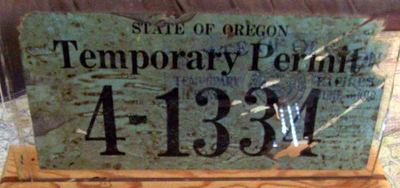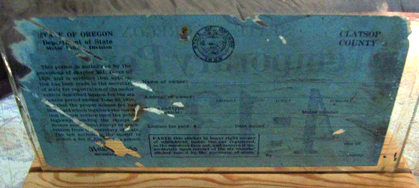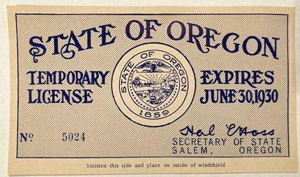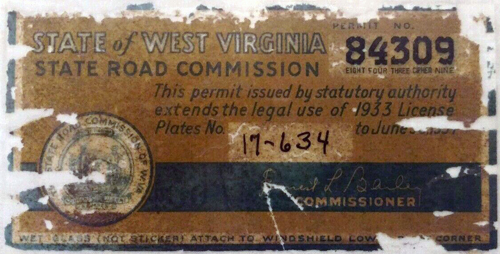|
British Columbia 1933 & 1934 Windshield Stickers |
|||||||||||||||||||||||||||||||||||||||||||||||||||||||||||||||||||||||||||
In the early 1930s, vehicle registration in British Columbia ran on the calendar year with license plates valid from January 1st to December 31st. Moreover, when renewing a vehicle, motorists were expected to pay their annual licencing fee up-front and in full on or before January 1st in order to obtain the following year's license plates. |
Local newspapers, businesses and the public had begun to lobby against the use of the calendar year for vehicle registration as paying a full year's licencing fees was seen as a hardship coming only a week after the Christmas holidays (public) and adversely affecting Christmas shopping (businesses), but the issue had yet to gain traction with the government. |
This began to change in 1932 when the Provincial Police noticed a drop in registrations and suspected that many motorists had ceased renewing their driver's licences and vehicle registrations as a way to save money as the Great Depression took hold. |
This prompted the Commissioner of the BC Provincial Police, J.H. McMullin, to write to all of the Police Chiefs in the province on June 10, 1932, that "from the returns received [to date] there is reason to believe that quite a number of persons driving motor-vehicles have not obtained renewals of their drivers' licences and no doubt they will continue to drive without a valid drivers's licence until such time as action is taken against them." |
It was subsequently determined that, in addition to a decline of 7% between 1931 and 1932 in the number of registered vehicles in the province, the total number of drivers licences issued exceeded vehicle registrations by 20,859 (e.g. 111,886 licences versus 90,977 vehicles). |
By December of 1932, it had become apparent to the provincial government that if a change was not enacted, many drivers would either remove their vehicles from the road entirely or operate their vehicle without proper registration creating the potential for even greater hardship if discovered and fined. |
The government was also concerned about a potential drop in revenues if motorists further decided to store their vehicles for 3 months in winter and wait for April 1st when discounted licences would be offered. |
Tolmie and his Cabinet (1928) |
On December 29, 1932, the Police Commissioner sent out a notice to police departments advising that arrangements were being made by the government to reduce the burden on motorists. |
 The solution devised by Premier Tolmie and his Cabinet was Order in Council (No. 1428), signed by the Lieutenant Governor the following day (December 30, 1932), which introduced the following allowances into the Motor Vehicle Act: The solution devised by Premier Tolmie and his Cabinet was Order in Council (No. 1428), signed by the Lieutenant Governor the following day (December 30, 1932), which introduced the following allowances into the Motor Vehicle Act: |
|
In effect, motorists were being enticed with two (2) free months of registration (January & February of 1933) if they paid their 1933 licence fees by March 1, 1933, as opposed to January 1, 1933. |
With only days to spare before the 111,836 drivers licences issued in 1932 expired, the province tasked the King's Printer with preparing the receipts and windshield stickers for issuance on January 1, 1933. |
Police Commissioner McMullin advised his staff that, once ready, the stickers would be forwarded by the Treasury Department with clear directions that motorists were to attach these on the "inside lower right-hand corner" of the windshield - which is understood to be the passenger side. |
Motorists would also be given to January 16, 1933, to make their first payment towards their 1933 licence and number plate, after which the Provincial Police would start taking action against un-licenced drivers. |
The Oregon Example |
In settling on the use of a windshield sticker, it is quite likely that BC was following the example set by Oregon three years earlier (1930) when it issued a temporary paper permit to be stuck to the inside, lower right corner of the windshield (why re-invent the wheel, right?): |
Uptake by Motorists |
The Vancouver Sun began to report on the uptake of the stickers at the Court House starting in January of 1933 and the lead-up to the end of the 2-week grace period on January 15, 1933: |
|
 The Vancouver Court House (1946) |
By March of 1933, it was being reported that approximately 9,000 motorists in Vancouver had paid the outstanding balance - being 75% of their annual fees - prior to the March 1st deadline, but that there were still approximately 1,000 motorists who had not paid up. |
In New Westminster, it was being reported that approximately 3,000 stickers had been issued to motorists and that 2,500 of the motorists had paid up, leaving 500 who had yet to do so. The loss of revenue to the government from these motorists was estimated to be $6,000. |
Counterfeiters take advantage |
Almost predictably, given the economic circumstances of the time, counterfeit stickers began to appear on cars in January of 1933 as a way to get around having to make any installments towards a 1933 license plate while continuing to use 1932 plates: |
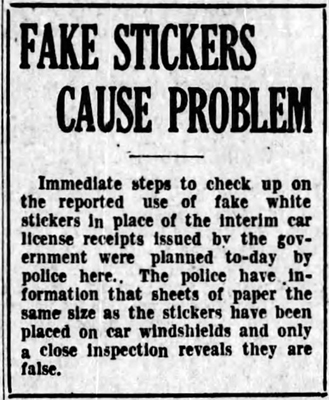 |
 |
Bonus, or no Bonus Months? |
In mid-January of 1933, the Police Commissioner felt compelled to dispel what he believed to be a misunderstanding that had arisen in relation to the changes and the fees that were to be applied going forward. Writing to his Police Chiefs, he advised that: |
There has been a persistent rumour that a full year's licence fee will be demanded on the 1st of March, 1933, which will expire on the 1st of March 1934, but this is not correct. Any person who takes out a motor-vehicle licence after the 1st of March, 1933, will be asked to pay the fees required by the "Motor-vehicle Act" at present, i.e.:
all of which licences will expire on the 31st of December, 1933, and will not carry the privilege of operating to March 1st, 1934, which is extended to those persons who take out their full year's licence on or before the 1st of March, 1933. |
As it turned out, the provincial government had different ideas and when the legislation was formally amended (see next section below), provision was made for the 1933 registration to expire on March 1, 1934. |
Formalizing the new Registration Year - "Extension" licences |
To formalize the ad hoc changes that had been made on December 30, 1933, the Motor Vehicle Act was amended in May of 1933 to, amongst other things, change the licencing year "from a calendar year to a year ending on the last day of February ..." The government also changed the licencing fee structure from one which was based on quarters (as outlined in the memo from the Police Commissioner above) to one that was monthly. |
Importantly, the amendments also extended "all licences for motor-vehicles other than motor-cycles which were paid in full on or before March 1st, 1933, to midnight on the 28th of February, 1934, and, for this purpose, stickers will be forwarded direct from this office to the registered owners of such motor-vehicles." |
The stickers were to be given to anyone who either:
|
For all others who had paid for their 1933 license plates in full prior to March 1, 1933, they would "receive, about the middle of December [1933], direct from [the Provincial Police] office, a 1934 Motor-vehicle (Extension) Licence free of charge." As with the 1933 windshield stickers, these were to be placed in the inside lower right-hand corner of the windshield. |
 |
|
The Provincial Police notified motorists of the changes through the inclusion of information as part of their annual renewal notice (top left) and included an "Extension" sticker and explanation of why they were receiving it and where it was to be placed on their vehicle. Notices were also placed in newspapers around the province (top right).
|
|
It was subsequently reported that 56,000 stickers were printed and mailed by the Provincial Police to registered automobile owners across the province by mid-December of 1933, thereby allowing them to continue operating their cars with 1933 plates throughout January and February of 1934.
|
The Cascade Exception |
The 1934 amendments to the legislation also included an interesting exception for motorists residing east of the Cascade Mountains that allowed them to cancel their registration prior to November 1st and receive a partial refund on their fees if they turned in their license and plates. |
This was in recognition of the difficulties of driving in "Deep Snow" country during the Winter months and the practice of motorists in places such as Nelson of "laying up" (storing) their vehicles until the Spring and the ability to apply for discounted licences on April 1st. |
As it was expected that many motorists east of the Cascades would take advantage of this option, when the "Extension" stickers for 1934 became available in November of 1933, the Nelson office of the provincial government ordered 100 stickers (in the form of 4 books containing 25 stickers each). |
The winter of 1933-34 was a generally mild one with "open conditions for motorists that at Nelson, where most of the street are clear, there is an unusually large number operating cars at the present time, which is normally almost mid-winter." |
As a result, the local offices in Nelson and Creston sold out of stickers by early January of 1934 and had to order more from Victoria. |
Notifying other Jurisdictions of the Changes |
Starting in the 1920s, British Columbia would provide a "Sample" licence plate to other province's and state's for identification purposes and ask for a "Sample" of their license plate in return. In 1934, the Provincial Police added an explanation of the change in the registration year as well as the validity of the "Extension" sticker:
|
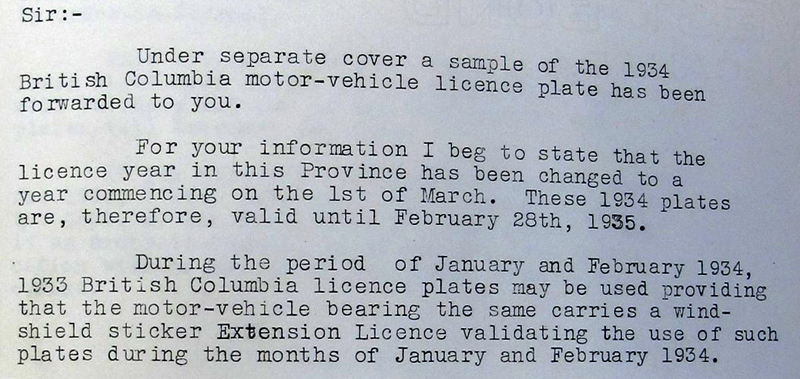 |
Dealer Plates |
For Dealers that qualified for an "Extension" license, special plates were prepared as it would not have been practical to affix stickers to cars being sold by these dealers. These plates are identified by the use of a "DX" prefix: |
.jpg) |
Additional information about Demonstration plates can be found on the Dealer's web-page (also linked below).
|
Learning the new system |
Not surprisingly, a certain level of confusion came with the use of the 1934 "Extension" stickers. Provincial Police were reminded to be confirm - to the best of their ability - that motorists seeking replacement stickers had, in fact, destroyed the original or needed a new one due to loss, incorrect mounting or some other issue that ultimately resulted in the destruction of the sticker, and that this need to be done before issuing a new one at a cost of fifty cents. |
Officials were also reminded that 1934 license plates were not to be issued until after February 15, 1934, and, throughout January and the remainder of February of 1934, motorists were to receive a 1933 license plate along with the "Extension" sticker. |
Where have all the windshield stickers gone? |
Something that is stuck to a windshield and only needed for a period of 8 weeks is not going to be common decades after last being needed. |
That said, given that thousands of these stickers were produced by the King's Printer between 1933 and 1934 it is highly unusual that not a single example appears to have survived or even a random photo of one on a vehicle! (NOTE: it is not known what is stuck to the windshield in the image at the top of this page, but we are hopeful it is a 1933 Windshield Sticker)! |
Yes, there have been rumours of them, including an apparent example that had been cut-out of a windshield and saved in a desk drawer (but subsequently misplaced and seemingly lost!) as well as paperwork in the BC Archives that hints at a sticker having been attached to a cover letter in one of their files at one time, but that is no longer there (or maybe never was?). |
This is even more confounding when one considers that British Columbia wasn't the only jurisdiction to make changes to extend its licencing year during the Depression and use windshield decals as a way to extend the use of already issued license plates. Yet, examples from these other jurisdictions have been saved, such as the sticker used by West Virginia to extend its 1933 license plates to June 30, 1934: |
Finding one of these stickers remains one of the remaining great mysteries in British Columbia license plate collecting! |
Quick Links: |
|
© Copyright Christopher John
Garrish. All rights reserved.


